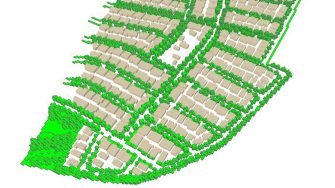
Project Aim (and/or Objectives)
Urban overheating is causing serious energy and environmental problems. Furthermore, the exposure to high temperatures and heat stress at the urban scale is a frequent cause of reduced health and well-being in an urban environment. To counterbalance the impact of high urban temperatures, several mitigation technologies have been proposed, developed, and implemented worldwide. Monitoring of several large-scale urban projects involving the application of mitigation technologies has shown the possibility to decrease the peak ambient temperature of the precincts up to 2.5 °C. Analysis reveals that the magnitude of the overheating depends on many parameters including the layout and the characteristics of the buildings and open spaces, the type of the building and paving materials, the anthropogenic heat released by vehicle exhausts and building heating and cooling, land use, and climatic conditions, etc. This project performs analysis of Menangle Park precinct existing and future scenarios to evaluate the effectiveness of different mitigation strategies.
The specific aims are:
- To investigate the impact of the new development and precinct design in the distribution of the ambient and surface temperature as well as on thermal comfort in Menangle Park precinct.
- To assess the cooling potential of the selected mitigation technologies when they are implemented in Menangle Park settlement.
Project outcomes
The results and conclusion have shown that:
- The average air temperature of Menangle Park precinct will increase by 1.4 °C after construction compared to the existing condition. The minimum and maximum ambient temperature will increase by 0.9 and 3.1 °C after construction, respectively.
- In total twelve mitigation scenarios (i.e., solar control, cool pavements, water, and greenery) have been simulated under the mean maximum summer condition which demonstrated a positive cooling potential during the warm season.
- The maximum reduction of ambient temperature achieved under the combination of proposed greenery is 4.90 °C during the mean maximum condition.
- Under the mean maximum condition, the average ambient air temperature for the unmitigated scenario in Menangle Park was 34.20 °C and the maximum and minimum temperatures were 37.16 °C and 32.39 °C, respectively.
- By applying proper mitigation technologies, the average temperature may be reduced by 1.2 °C.
- Under the mean maximum condition in summer, the combination of proposed greenery reduces the minimum and maximum air temperature by 1.3 °C and 1.6 °C, respectively, compared with those in the reference scenario.
- Cool material (the combination of cool pavement and cool roof) is the most effective strategy in reducing the average temperature of the whole settlement by 1.2 °C when it is applied in all roofs, roads, and pavements. The combination of proposed greenery is the second most effective strategy to reduce the mean ambient temperature of the settlement.
- Cool pavement and Greenery (the combination of three stages of tree planting) are the most effective strategies to reduce the maximum ambient temperature of Menangle Park settlement.
- Water spray system is the most effective strategy to reduce the minimum air temperature (4.7 °C under north east and 1.9 °C under south west wind directions).
- From the comfort analysis, Menangle Park presents strong to extreme heat stress under the mean maximum condition in the unmitigated scenario. Shading is very effective strategy to reduce the impacts of solar radiation and improves thermal comfort at the pedestrian level.
- The combination of proposed planting tree and greenery, use of cool pavement, and shading are very effective strategies in reducing surface temperature of the street and pavements under the two investigated wind conditions.
- Increasing the greenery cover by 25% compared to the combination of the stage 1, stage 2, and hilltop park adds a further reduction of 0.5° C in the maximum air temperature, and 0.3 °C in the average temperature compared to the initial combination of the three strategies. Additional trees (well irrigated) in north-eastern side of the site helps to reduce the temperature of the advected air in the settlement and provide shading.
Figure 1 Combination of stage 1, stage 2, and Hilltop Park (a), stage 1 proposed greenery(b), stage 2 proposed greenery (c),and hilltop park (d)
Figure 2. Ambient temperature distribution in the reference scenario for the north east (top) and south west (bottom) winds
Project participants
Project Leaders: Scientia Prof Mattheos Santamouris, Dr Shamila Haddad
Contact person
Prof Mattheos Santamouris, m.santamouris@unsw.edu.au
